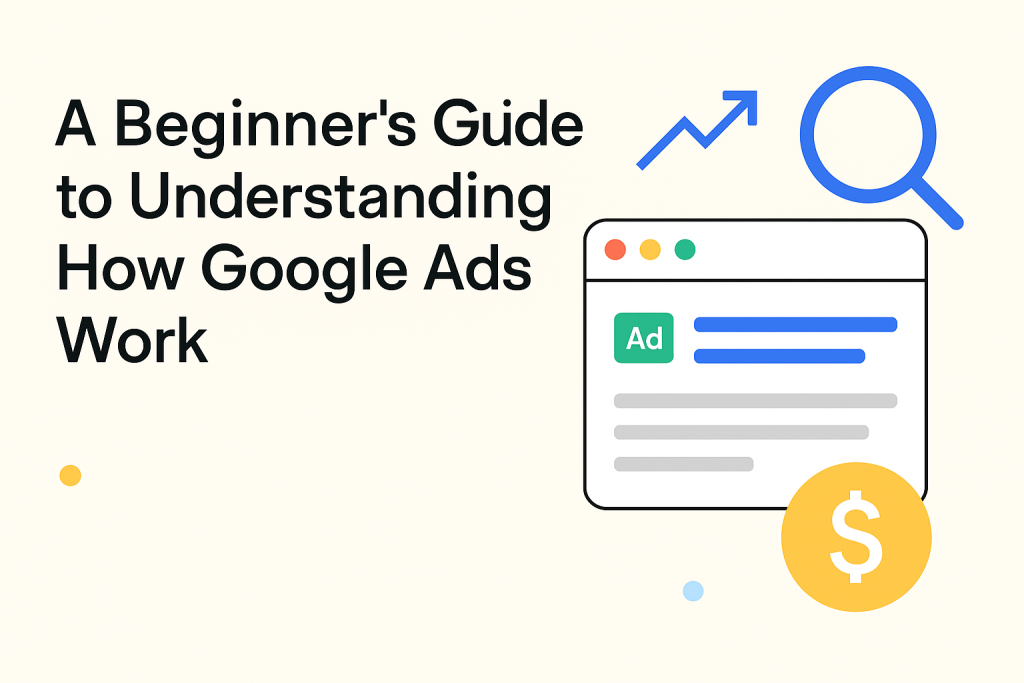Whether you’re a small business owner, a marketing manager, or just curious about digital advertising, understanding how Google Ads work is a crucial step toward increasing your online visibility and driving qualified leads. Google Ads (formerly known as Google AdWords) is one of the most powerful platforms in digital marketing, but it can feel overwhelming if you’re new to it.
In this guide, we’ll break down the basics of Google Ads, how the platform works, and how you can start leveraging it to meet your marketing goals.

What Is Google Ads?
Google Ads is an online advertising platform developed by Google, where advertisers bid to display brief advertisements, product listings, or videos to web users. These ads can appear in Google Search results, on YouTube, in Gmail, and across millions of websites in the Google Display Network.
The most common format is Search Ads—the sponsored results you see at the top of a Google search page.
How Do Google Ads Work?
At its core, Google Ads operates on a pay-per-click (PPC) model. That means you only pay when someone clicks on your ad.
Here’s a breakdown of how it works:
1. Keywords Are the Foundation
When you create a campaign, you choose keywords—terms or phrases your potential customers might type into Google when looking for products or services like yours. For example, a bakery in Austin might target “custom birthday cakes Austin.”
2. The Auction System
Google runs a lightning-fast auction every time someone performs a search. Advertisers with relevant keywords can enter the auction, and Google uses a combination of factors to determine whose ad shows and in what order:
Bid amount – How much you’re willing to pay per click.
Quality Score – A score based on your ad’s relevance, expected click-through rate, and landing page experience.
Ad Rank – This is your bid multiplied by your Quality Score. It determines your ad position.
3. Ad Formats and Placements
Google Ads offers multiple ad formats:
Search Ads – Appear on Google search results pages.
Display Ads – Banner ads on websites in the Google Display Network.
Video Ads – Primarily on YouTube.
Shopping Ads – For e-commerce products with images and pricing.
App Ads – Promote mobile apps across Google’s properties.
As a beginner, most people start with Search Ads because of their high intent—users are actively searching for what you offer.
Key Components of a Google Ads Campaign
To launch an effective campaign, you’ll need to understand these core elements:
Campaign – The highest-level structure. You choose your goals, budget, and settings here.
Ad Groups – Each campaign contains ad groups that house related keywords and ads.
Keywords – Trigger your ads based on user search queries.
Ads – The text (or image/video) people actually see. A good ad is clear, relevant, and includes a strong call-to-action.
Landing Page – Where users go after clicking. A relevant, fast, and optimized landing page improves Quality Score and conversions.
Why Quality Score Matters
Google rewards relevance. The better your ad experience—from keyword to landing page—the higher your Quality Score. A higher Quality Score can:
Lower your cost-per-click (CPC)
Improve your ad position
Increase your return on investment (ROI)
In short, you can pay less and rank higher if your ads are well-optimized.
How Much Does It Cost?
Google Ads offers complete control over your budget. You set:
A daily budget per campaign
A maximum bid per keyword
Optional automated bidding strategies based on your goals (like maximizing conversions or clicks)
Costs vary widely depending on industry, competition, and location. In high-competition industries (like legal or insurance), you might pay $20–$50+ per click. In less competitive niches, clicks can be under $1.
Getting Started: Tips for Beginners
Start with a Small, Focused Campaign
Choose one product or service to advertise, and build a tight ad group around highly relevant keywords.Use Exact Match and Phrase Match Keywords
Avoid broad matches in the beginning—they can drain your budget with irrelevant clicks.Write Compelling Ad Copy
Highlight benefits, include your keywords, and use strong calls-to-action.Optimize Your Landing Page
Make sure it aligns with your ad and delivers a great user experience.Track Everything
Use conversion tracking and link Google Ads with Google Analytics to measure what’s working.
Final Thoughts
Google Ads isn’t magic, but it is a proven, data-driven way to reach customers who are actively searching for what you offer. With a clear understanding of how it works and a strategic approach, even beginners can see strong returns from their ad spend.
As you grow more comfortable, you’ll discover deeper optimization tactics—like A/B testing ads, using negative keywords, and setting up remarketing campaigns—that can elevate your performance even further.
At DataSciMarketing.com, we believe in using data to drive smart marketing. Google Ads provides a goldmine of that data—it’s just a matter of knowing how to use it.
Ready to dive deeper into paid search or want help launching your first campaign?
Stay tuned for our next guide on Google Ads keyword strategies, or contact our team to talk with a digital marketing expert.

